Want to Purchase Fast Growing Baby Poplar Trees

Wide spaced row of (I think) Tower poplar on a farm road near Camrose. Note the smaller orange leaved trees between them.
Columnar Poplar
These four trees have one thing in common: They are all 4 to 8 times as tall as they are wide: Very narrow for their height.
Uses
- Plant by front sidewalk and driveway as partial screen. (Space at twice their nominal width -- so Prairie Sky is nominally 10-12 feet wide, space 20-25 feet apart)
- Acreages: Set back from driveway on 15 foot spacing for a formal 'Avenue of columns' entrance.
- Quick privacy screen. (Best practice: Alternate with a tall shrub. Swedish aspen lose their lower branches as they get older when grown close enough to touch.)
- Windbreak: Use as one row when space is restricted. Provides shelter to establish better, long term windbreak trees such as white spruce. Use Prairie Sky or Sundancer for this application.
Places they don't belong
- City lots. All poplars sucker. New trees will pop up a a foot to 25 feet away. They have big shallow roots that can lift sidewalks and driveways.
- Close to the house. Especially true if you have certain kinds of clay soils. The tree drains the clay during the summer, clay shrinks. In winter, it gets wet, expands. Possible cracked basement. Bearing that in mind, I had 5 of them over 75 feet tall within 10 feet of my house. I took them down when they were dying of old age. I have the right type of clay, I guess.
- Near your garden. suckers.
- Near your septic field.
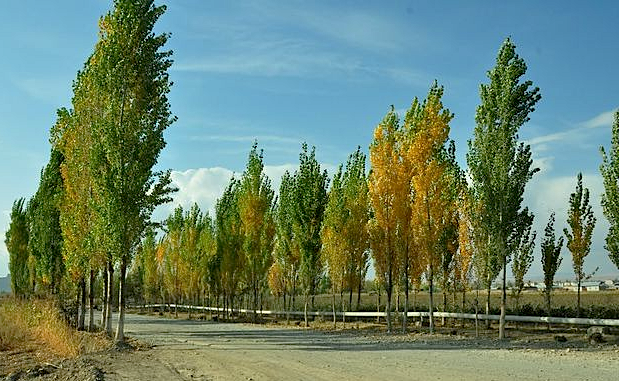
An example of columnar poplar (Prairie Sky, I think) used as a boulevard tree in a rural setting
To Fluff or Not to Fluff
Poplars are dioecious -- male and female flowers are on separate plants. All four of these cultivars are male: Some pollen in the spring. No fluff later.
Columnar poplar are FAST. With good growing conditions, (keep damp, fertilize lightly in October and June) it will grow 5 feet a year, once established. Even the first year in it's new home they often put on a two feet or more.
All poplar need lots of sun. -- at least 6 hours a day of full sun. You can't plant them even in their own shade. If you have a poplar bush you are trying to rejuvinate, you can't just plant baby poplars in among the poplars. (See Rejuvenating Poplar Bush)
Poplar tend to shed their lower branches when they are shaded. Basically, the tree is abandoning unproductive food factories, and concentrating it's resources on the more productive leaves near the top.
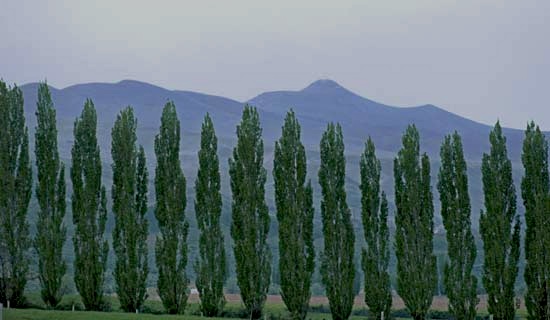
Think about a row like this on either side of your acreage driveway. This is a row of lombardy poplar, a tree with a similar size and shape to Prairie Sky. (Lombardy isn't hardy here.)
Columnar poplars as screening trees
Planting them too close together will result in lower branches falling off. I don't recommend these trees for screening
-
As mentioned above, the lower branches are shed when shaded. Planted close together, the lower branches are more quickly shaded. 10 years after you plant them, the trees are 25 -35 feet tall with branches only on the top half of the tree. The effect is about as private as a barb wire fence.
-
The elegance of these trees is their narrow shape. In a screening row, you lose this, and just get a green wall. Plant a row of willow if you want a green wall. They are good at walls.
-
If you are working with a confined space, alternate a poplar with one of the larger shrub willows, such as Flame, or a shade tolerant tree like high bush cranberry. They will fill in the space between the poplar, and will give you a picket fence effect.
I lose sales because of this advice. At best I sell half the trees I could. So be it. It's important to me that you get the right tree, and use it in a way that is beautiful. In the long run, I figure that giving the best advice I can will pay off.
Columnar Poplar on the Acreage
- 15 feet back from the driveway, plant a poplar every 30 feet on both sides. Another 15 back plant a lodgepole pine, scots pine, or spruce lining up with the spaces. The poplar in a very few years will provide a colonnade on either side of the driveway. The pines will later take over this role, being majestic when the poplar are nearing their end of life.
- Plant as one row of a screen along the road allowance. Alternate poplar and two red osier dogwoods half way up the ditch bank. (Check your county's road edge bylaws: Some like larger margins) Being halfway up, they will have access to the extra water that accumulates in the ditch. Poplar is moderately salt tolerant, but if your ditch is immediately next to a heavily salted hill or intersection, try one or two trees the first year. Back this up with a row of golden willow alternating with spruce. *Plant 6 or 12 in a circle 50 to 100 feet across. This will give the 'Stonehenge' look. A mystic circle. Plant a single oak tree at the center to extend this effect. You can combine this with Oriental style wooden trellises.
In any case, I suggest leaving room for your mower between the trees and the property edge. This makes keeping it neat looking quite easy.
Poplar are normally water pigs. It's hard to overwater, and they prefer soils that are constantly moist. Loam is best. They tolerate fairly heavy clay soils, but do not do well in a water logged clay soil. If planted in sandy soil they will need supplemental irrigation their entire life.
Poplar are not long lived trees. Plan on replacing them in 50-75 years.
Let's go from tall down to short.
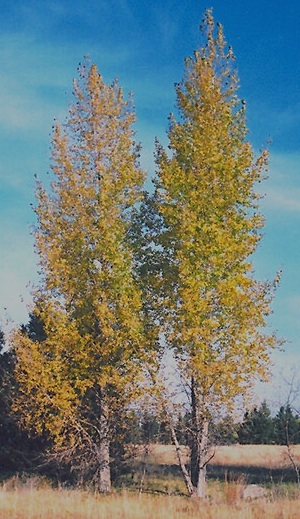
Young Prairie Sky poplar.
Prairie Sky
This tree is supposed to get to 80 feet tall by, (depending on whose lies you believe,) between 8 and 12 feet wide. Trouble is, I've not been able to find a picture of a mature one. I suspect they are looking at the parents, and siblings -- varieties that shared the same parents. You too can be part of an adventure.
Prairie Sky is a better alternative to Tower poplar. Tower has similar parantage, but is subject to bronze leaf disease (not as susceptable as Swedish aspen) Tower also gets stem canker.
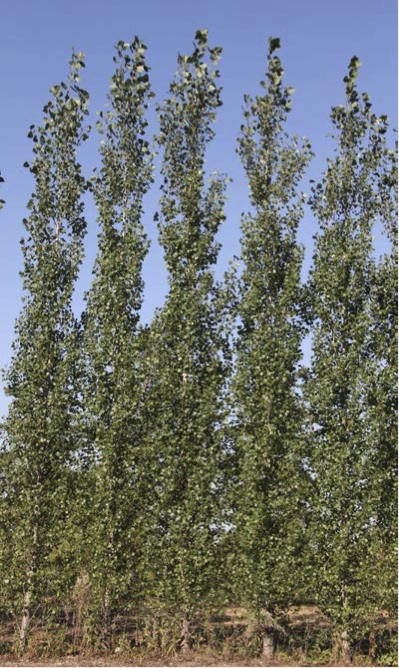
Sundancer poplar. Image courtesy Poplar and Willow Council
Sundancer
If Prairie Sky is a bit much for you, consider Sundancer. Same width, half the height. We'll see. The ones in my arboretum seem to be about 1/5 as wide as they are high. So far sundancer has a very smooth outline much like a candleflame.
More info about Sundancer (PDF fact sheet, Poplar and willow council) Alternate link Sundancer
Prairie Skyrise Trembling Aspen
This is a mutation of our native trembling aspen. It basically makes lots of short branches from the trunk, rather than a few long ones. The tree has very little taper -- it's basically a cylinder of closely spaced leaves. However it is an aspen, and has all the troubles our native trembling aspen have: Suckers, a bunch of bugs that like to eat it, fall colour that doesn't stand out. Because of the tight packed leaves it also gets a few fungi that take advantage of the high humidity of all those leaves sweating in a confined space.
Production as of 2016 isn't anything to write home about. Stay tuned.
2020: I no longer recommend this tree. I can get it as a special order item. Please contact me in fall for spring delivery.
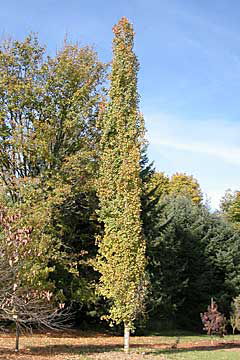
A fine example of a mature Swedish Aspen starting to turn colour in the fall. In an open sunny location like this, Swedish Aspen will hold on to their lower branches.
Swedish Aspen
Swedish aspen is the tree for fast growth in small spaces.
- Similar in height to Trembling Aspen, but with branches almost parallel to the trunk. Makes a tree that is very narrow.
- Golden fall colour.
- Leaves rustle in lightest breeze.
- Non-suckering.
- Good tree for small space.
- Formal look. Looks good in spaced rows.
- 3-5 feet per year.
- Only gets about 3-4 feet wide.
- Very little suckering compared to other poplar.
- No fluff.
- Good on heavy clay soils.
Swedish Aspen is a cultivar of European trembling aspen with a much more acute node angle. The branches ascend almost parallel to the trunk. This makes for a tree that is shaped like a candle flame. Very striking.
Because of it's size, it is ideal for use on small yards, and can be used fairly close to the house. It's tall upright habit make it formal looking. Because it's a poplar it grows fast. It is a good tree to plant while you wait for your other trees to get big.

Swedish Aspen in a residential neighbourhood. This tree is on the north side of fence. Getting steady shade, it's dropped all branches that are shaded by the fence.
Some garden centres will claim that Swedish Aspen does not sucker. Not true. While it is less prone to suckering than many of the poplar family, it will sucker when its roots are damaged. If you plant a flower bed that gets regular shovel work near an aspen, you will get suckers in the flower bed. You will also get occasional suckers in the lawn, but these are dealt with by the mower.
Finally a warning: Poplar roots are invasive. For obvious reasons they should not be planted on or near septic fields. They will find their way through small cracks in pipes. This can be a problem with older sewer lines (non-plastic) as the joints on these frequently leak. It can also be a problem if you have weeping tile near the surface. Weeping tile at the foot of a basement foundation is not usually at risk from poplar. Their roots are mostly right at the surface. This is not a problem with poured concrete foundations. It is not a problem with water lines, or ABS (black plastic) sewer lines.
Swedish Aspen leaves aren't green when they open. Rather they are rusty orange to red. The leaves open without any chlorophyll, but with some of the carotenoids (xanthophyll -- yellow & lycopene -- red) and anthocyanins (red, purple pigments) in place. In cool weather they will maintain this colour for one to two weeks. In warm weather it lasts only a few days. This same red pigment on some years gives the fall foliage a pink colour.
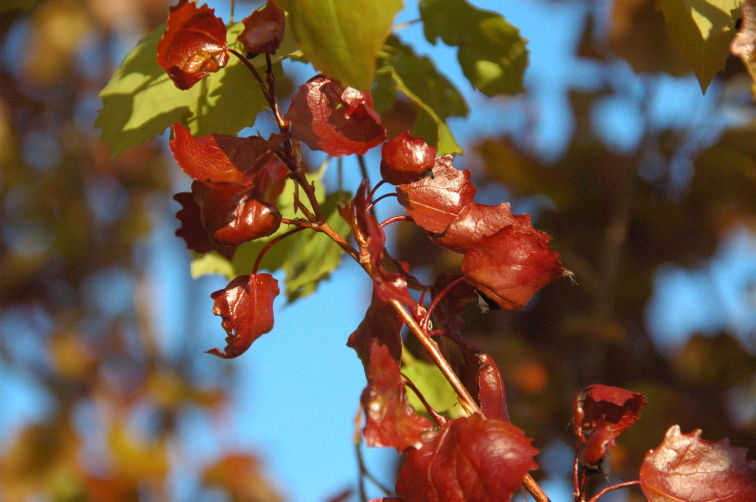
The leaves when first open can range from dark red to rusty orange. Notice how thin and fragile the leaf looks. It will fill in a few days.
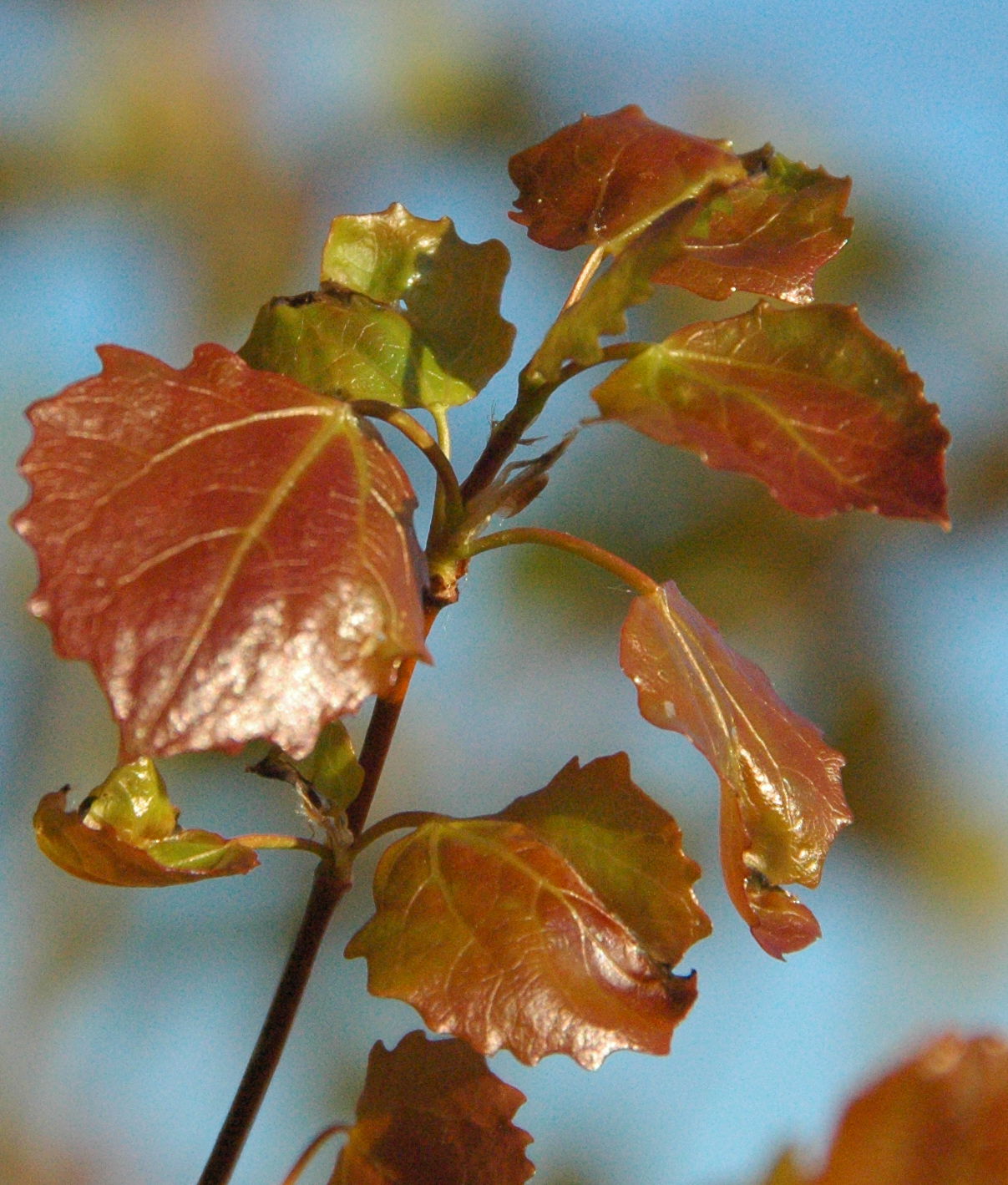
With exposure to warm temperatures and sunlight, the chlorophyll factories start up, turning the leaf green.
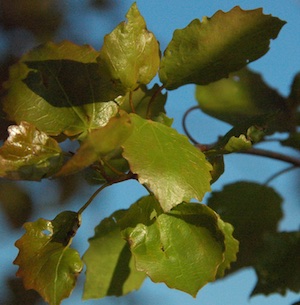
Ok. I need a pic of a green leaf. Stay tuned.
Swedish Aspen and Bronze Leaf Disease
Swedish Aspen is susceptible to a fungus called Bronze Leaf Disease. Individual leaves, and clusters of leaves turn rusty red or copper coloured in late summer. The veins remain green. The leave doesn't get 'crispy' the way you would expect a dead leaf to, but is sort of leathery. The fungus will spread inward down the stem, eventually killing the tree.
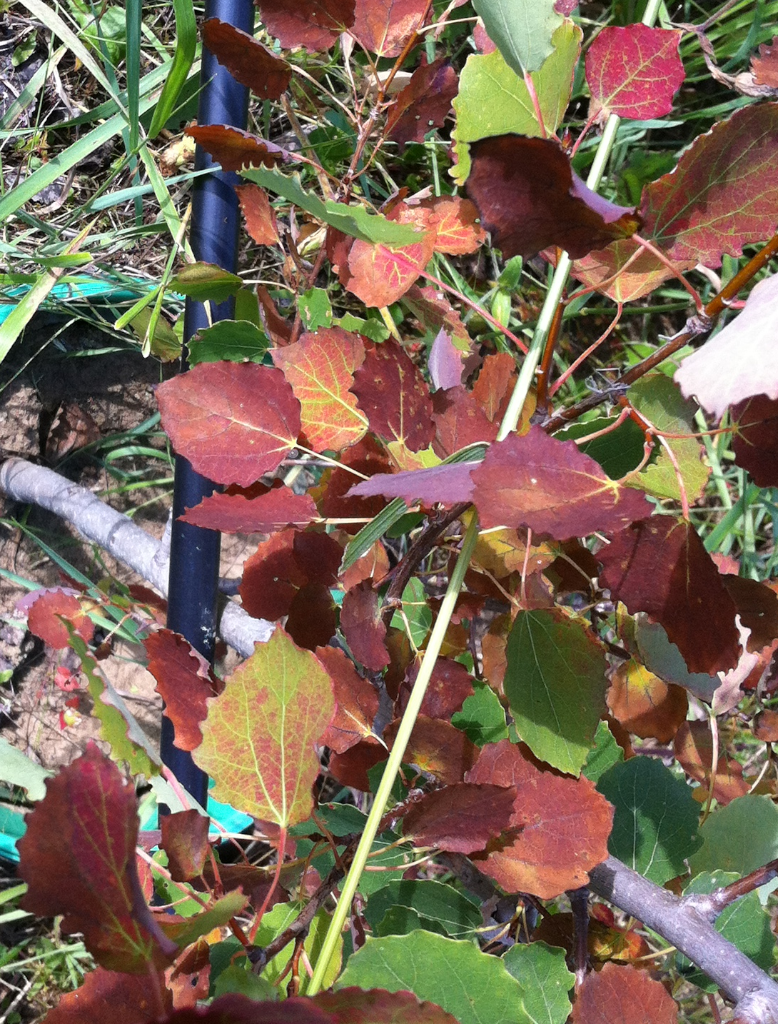
Closeup of infected leaves

Here's a look at a typical infected tree. You can see that finding and removing all of the affected leaves is a time consuming operation. Hard enough with an 8 foot tree, imagine doing this on a 30 foot tree.
Infected leaves often stay attached to the tree over winter.
The fungus overwinters in the leaves either on the tree or on the ground. In spring, the fungus releases spores which infect newly opened leaves. The leaves are without symptoms until late August. In addition the fungus will grow down the interior of the twig. When it reaches the roots it will kill the tree. Swedish aspen planted in a row will share roots, so one untreated infected tree can kill a row in a few years.
All Swedish Aspens are clones from a single specimen. There is no chance to breed a resistant type. There is no treatment for BLD at this time except immediate pruning of infected branches.
One producer in Manitoba and another in Saskatchewan have stopped growing Swedish Aspen. Control measures were taking too much time. Manitoba summers tend to be hot and humid, much more humid than Alberta generally, so it may be possible to control here.
You can fight a delaying action:
- Remove any infected leaves immediately. If more than a quarter of the leaves on a twig are infected remove the twig 12" below the bottom infected leaf. Burn or dispose of with your garden waste. The spores remain viable through most household compost processes.
(Not hot enough) - In fall do a careful job of leaf removal. Do not mulch aspen leaves into the lawn with your mower. The easiest way to get all the leaves is frequent vacuuming with a leaf bagger. An extension tube may allow you to get higher leaves off the tree.
- After leaf drop carefully examine your aspen trees for clinging leaves. You may be able to knock them down with a directed hose spray. If the tree is sturdy enough, lean a ladder against it, and remove by hand.
- If you have a badly infected tree, or you can't reach the affected part, cut it down. Check the cut for black spots. Keep cutting back until you get a clean stump.
You may be able to train up one of the inevitable suckers to replace it. - You can try Bordeaux's Mixture as a treatment. Don't know that it works, but don't know that it doesn't. It is effective against other fungi on grape vines, and it's cheap, and not particularly hazardous. Spray weekly starting as the buds start to open. Then spray on any infected leaves later. Report back to me on your results.
- Pruning should be done with two pairs of pruners. It takes 30 seconds for a 10% bleach solution (1 part bleach, 9 parts water) to kill the fungus. Make a cut, exchange with the one in the soak. The reduces the chance of re-infecting a branch when you make the cut. Use cheap pruners, as the bleach solution is hard on them. Drop in a bucket of plain water when you are on a break, clean and dry at the end of the day.
Prevention
Here are some steps you can use to keep out of trouble:
- Buy aspen no earlier than mid September. This guarantees that you are getting clean stock. I have seen infected trees at major box stores. I have bought infected trees from major suppliers. I recommend waiting until mid September. This will often allow you to catch them on sale.
- Do NOT plant the Great Green Wall. The close environment makes for higher humidity and the minor injuries the leaves and twigs get from hitting each other in the wind make it easier for the infection to spread. Space them at least 10 feet apart.
- Try to reduce humidity around the poplars. Don't let the leaves get hit by sprinklers. Do your watering near them in morning so leaves dry off.
- If your neighbours are growing Swedish Aspen, then you shouldn't. One of the reasons this disease spreads so well is that the tree is overused.
Alternatives
One answer is to plant something else. The closest tree is a North American trembling aspen cultivar called Prairie Skyrise. It and a raft of other options are detailed here: Skinny Trees
Another answer is to build a trellis, and grow vines. I don't do vines yet (although I have just started this year with grapes).
Got something to say? Email me: sfinfo@sherwoods-forests.com
Interesting? Share this page.
Want to talk right now? Call me: (8 am to 8 pm only, please) 1-780-848-2548
Do not arrive unannounced. Phone for an appointment. Why? See Contact & Hours That same page gives our hours of operation.
Back to Top
Copyright © 2008 - 2021 S. G. Botsford
Sherwood's Forests is located about 75 km southwest of Edmonton, Alberta. Please refer to the map on our Contact page for directions.
Want to Purchase Fast Growing Baby Poplar Trees
Source: https://sherwoods-forests.com/Trees/Leaf_Trees/Poplars/Columnar_Poplars.html
0 Response to "Want to Purchase Fast Growing Baby Poplar Trees"
Enviar um comentário